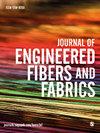A new modeling method to predict the mechanical properties of braided composites
IF 2.3
4区 工程技术
Q1 MATERIALS SCIENCE, TEXTILES
引用次数: 0
Abstract
The present research signifies a new modeling method for calculating the stiffness of braided composites. In previous works, the modeling approach has been related to repetitive unit cells for analysis of braided composites based on a single area or a few added areas. Also, no confirmed modeling method has recently been available for braided composites because of different fibers’ configuration considerations. Therefore, there is no preferred one, and fiber bundle arrangements are complex in practicality; it is unclear whether their shape is straight or curved. Also, the previously proposed mesoscale repetitive unit cell models have many elements and nodes in the finite element analysis phase, so applying periodic boundary and mesh conditions can mislead the results when they are used. So current research proposes a multi-cell multi-domain strategy and verifies it for modeling and computation of mechanical properties while showing the significance of braiding path and manufacturing process. The currently proposed method is tested with selected sections’ configuration and shown for actual braided composites’ scenario. So, according to the literature, the section is modeled as a complex shape with a squeezing effect. Then, that model is analyzed, and calculated properties are verified by the existing methods and found results with a maximum and minimum difference of 2.7% and 0.25%, respectively. Afterward, it is divided into cells, which are then analyzed and checked to determine which number of simplistic division stages can represent a section. It is found that a minimum of 15 divisions can be defined with a maximum 2% difference, and over that has approximately the same results as of the current considered section model. Additionally, the study examines how the elastic constants of 2D braided composites are influenced by the braiding angle and fiber volume fractions.一种预测编织复合材料力学性能的新建模方法
本研究为编织复合材料刚度计算提供了一种新的建模方法。在以前的工作中,建模方法涉及到基于单个区域或几个添加区域的重复单元格,用于分析编织复合材料。此外,由于纤维结构的不同,目前还没有确定的编织复合材料的建模方法。因此,没有优选的一种,纤维束排列在实用性上比较复杂;目前还不清楚它们的形状是直的还是弯的。此外,先前提出的中尺度重复单元胞模型在有限元分析阶段具有许多单元和节点,因此在使用时应用周期性边界和网格条件可能会导致结果的错误。因此,目前的研究提出了一种多单元多域策略,并对其进行了验证,以进行力学性能的建模和计算,同时显示了编织路径和制造工艺的意义。目前提出的方法在选定截面的配置下进行了测试,并在实际编织复合材料的场景中进行了演示。因此,根据文献,将截面建模为具有挤压效应的复杂形状。然后,对该模型进行分析,并通过现有方法对计算性质进行验证,得到的结果最大和最小差值分别为2.7%和0.25%。然后,将其分成细胞,然后对其进行分析和检查,以确定哪些数量的简单分裂阶段可以代表一个部分。结果发现,最小15个分区可以定义,最大差异为2%,超过这个范围与当前考虑的分段模型的结果大致相同。此外,研究了编织角和纤维体积分数对二维编织复合材料弹性常数的影响。
本文章由计算机程序翻译,如有差异,请以英文原文为准。
求助全文
约1分钟内获得全文
求助全文
来源期刊

Journal of Engineered Fibers and Fabrics
工程技术-材料科学:纺织
CiteScore
5.00
自引率
6.90%
发文量
41
审稿时长
4 months
期刊介绍:
Journal of Engineered Fibers and Fabrics is a peer-reviewed, open access journal which aims to facilitate the rapid and wide dissemination of research in the engineering of textiles, clothing and fiber based structures.
 求助内容:
求助内容: 应助结果提醒方式:
应助结果提醒方式:


